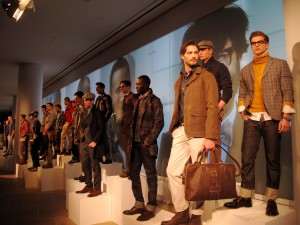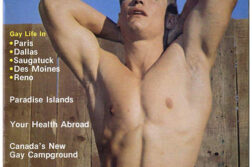ONE OF MY ROLES as a senior features editor at Town & Country was that of men’s fashion editor, a subject and an arena that I didn’t know at all well but was hired to cover, as the editor-in-chief wanted someone who simply knew the expensive name brands. At my first interview, the editor said, “All I need is someone on staff who knows names like Zegna.” It happened to be the brand of suit I was wearing, and when I unbuttoned my jacket and held it away from my chest for her to see the label, she hired me on the spot.
During my run at the magazine, apart from getting feature stories on a variety of cultural topics and acting as the “Social Manners” columnist, I previewed the next season’s new collections of men’s clothing from high-end designers. One of them was Ralph Lauren. On one occasion, as soon as I arrived at the showroom to see their fall line, I was told by the director of public relations, a late-twenties, ethereally smooth young man—in both manner and skin—that all the models had finished for the day. It was six o’clock, and I had been the last scheduled appointment. Their workday was over.
This young man, named Lance, apologized for this development when he greeted me at the elevator, helping me off with my fashionable knee-length car coat and then handing it to a white-jacketed cater-waiter. “All the boys are getting dressed now,” he said, referring to the models. “Or, I should say, getting redressed in their street clothes. But I can still show you the line on our mannequins.” Ralph Lauren was one of the few brands, I discovered, that regularly used live models in the showroom—impossibly handsome college-age lads hired to wear the outfits that would be for sale in stores six months later.
 Another high-end menswear maker, the Neapolitan-based Gianluca Isaia, did something even more dramatic every season. Isaia hosted press dinners in his Manhattan showroom, often beginning the event with a cocktail reception with a hip-hop DJ at the controls atop his block-long terrace overlooking 57th Street. At these events, Isaia injected a few models into the select crowd of guests, so that, while speaking to an exquisitely dressed young man, you might not know that he’d been hired to be there. Suddenly he might say, “Well, it’s funny you should mention linings, because Isaia is famous for what he does with linings,” and he would then shimmy out of a windowpane blazer to show off a paisley silken interior, folding back a lapel and collar to reveal a bold ribbon of color on the reverse. Later, during the sit-down dinner, these same young men would saunter about the table while some executive from the company would give a running narrative about each wardrobe, reminiscent of a scene from a 1950s movie about a couture fashion show. The young men would approach everyone at the table so that each guest editor could examine the clothes up close, finger the material, discern the subtleties of buttons.
Another high-end menswear maker, the Neapolitan-based Gianluca Isaia, did something even more dramatic every season. Isaia hosted press dinners in his Manhattan showroom, often beginning the event with a cocktail reception with a hip-hop DJ at the controls atop his block-long terrace overlooking 57th Street. At these events, Isaia injected a few models into the select crowd of guests, so that, while speaking to an exquisitely dressed young man, you might not know that he’d been hired to be there. Suddenly he might say, “Well, it’s funny you should mention linings, because Isaia is famous for what he does with linings,” and he would then shimmy out of a windowpane blazer to show off a paisley silken interior, folding back a lapel and collar to reveal a bold ribbon of color on the reverse. Later, during the sit-down dinner, these same young men would saunter about the table while some executive from the company would give a running narrative about each wardrobe, reminiscent of a scene from a 1950s movie about a couture fashion show. The young men would approach everyone at the table so that each guest editor could examine the clothes up close, finger the material, discern the subtleties of buttons.
But these were the exceptions. Most design brands simply showed the garments hanging on racks or mannequins, albeit in showrooms so well-appointed and plush that they could be boutiques or alcoves of luxe department stores.
As Lance led me through the loft-like space, stopping at the groupings of mannequins as if the figures and props were museum dioramas, some of the live models, now dressed in their street clothes, were leaving for the evening. Each of them was polite, saying goodbye to Lance, thanking him for the day of work. Some hugged him frat-bro style, heartily slapping his back repeatedly as if it were a bongo. And yet, their beauty was still immediately evident, their faces so clear and pretty that anyone on the street—straight or gay man, teenage girl or elderly woman—would have been struck by their visages. Their faces and whatever skin was visible were so unblemished that the young men appeared nearly out of focus, as in a Doris Day movie filmed through a gauzy lens.
But some of the models might easily be passed by on the street, their beauty muted or concealed by clothing or the elements. For now they were garbed in baggy jeans that fell practically mid-cleft, so that the brand of underpants orbiting their narrow waists was announced to everyone, as if that were their name, stamped in ink by their mothers for summer camp. Dowdy, oatmeal-colored wool-knit caps were pulled low on their brows; battered, decaled skateboards were tucked under their arms as they read text messages that had collected on their phones.
It was dark on Madison Avenue when I left the showroom and whooshed through the revolving doors after my tour of the mannequin-clad outfits. Rush hour was still at its height. This was the time of evening, the setting, that those of us who moved to New York after college from elsewhere in the country imagined occupying—the traffic exhaust rippling taillights into a frenzy of miniature fires, a bright forest of skyscrapers rising around us, currents of people coursing the sidewalks.
A group of the models had gathered on the sidewalk. Puffs of breath rose in the chilly air like the smoke from magicians’ tricks. They lit cigarettes, thumbed texts, spoke into their phones (which lit their faces with a bluish glow), and affixed earbuds with the delicacy of women putting on earrings. None of them was any longer dressed well, or, rather, expensively. The clothes they wore were right for their ages and bodies and stations in life. In that sense, they were fashionable. They had worn costumes, some might even say uniforms, for the hours during which they had been employed. Now, off the clock and off the plinths on which they had been posing as if Classical statuary, they had changed out of those outfits and into the ones they had fashioned for themselves.
I learned over the two years that I covered men’s fashion for the magazine that most of these young men are straight, a fact I can’t fully account for. I also never adjusted to the fact that these same young men are routinely referred to as “boys” by those who hire them for the showroom or runway presentation, as well as among themselves. By calling them boys, they are being emasculated, desexualized, made to seem sexually unavailable to the men (and women) in power at magazines and department stores who may nonetheless desire them.
And yet, of course, these young men understand male beauty and the sexual power it elicits. They recognize beauty and its value, æsthetically and monetarily. They see beauty staring back at them in the mirror when shaving or flossing, and they see it in the faces and physiques against which they compete at open calls and auditions. The largely gay male fashion editors who come through the showroom during the day sometimes flirt with the young men, but more often they work extra hard not to show any admiration for them or reveal the state of perplexity that such beauty can inspire. You might comment on a placket that runs the length of their long torso or the hue of velvet along a Chesterfield collar that grazes a blush-streaked jaw, even draw your face close enough to pick up their scent; but you would not touch them. You don’t want them to know that you desire them, because that gives them a kind of power over you. So I examined the clothes the young men donned, recorded my notes on a pad, and nodded a greeting as I did so, then continued on, assuming my professional pose.
When you see beauty such as that possessed by the models, an outsider’s response is atavistic, primal. Beauty may be in the eye of the beholder, but there is a universality to it; we all know it when we see it. Being on the receiving end of this admiration places these guys in a kind of unspoken but universally recognized elite. To admit that it exists might be to shatter the illusion that these are models just like you and me, men whose clothes we would like to wear. So when they go out, they tend to dress in standard attire for the time and place, not going out of their way to advertise, as if they needed to.
David Masello is a writer based in NYC.






